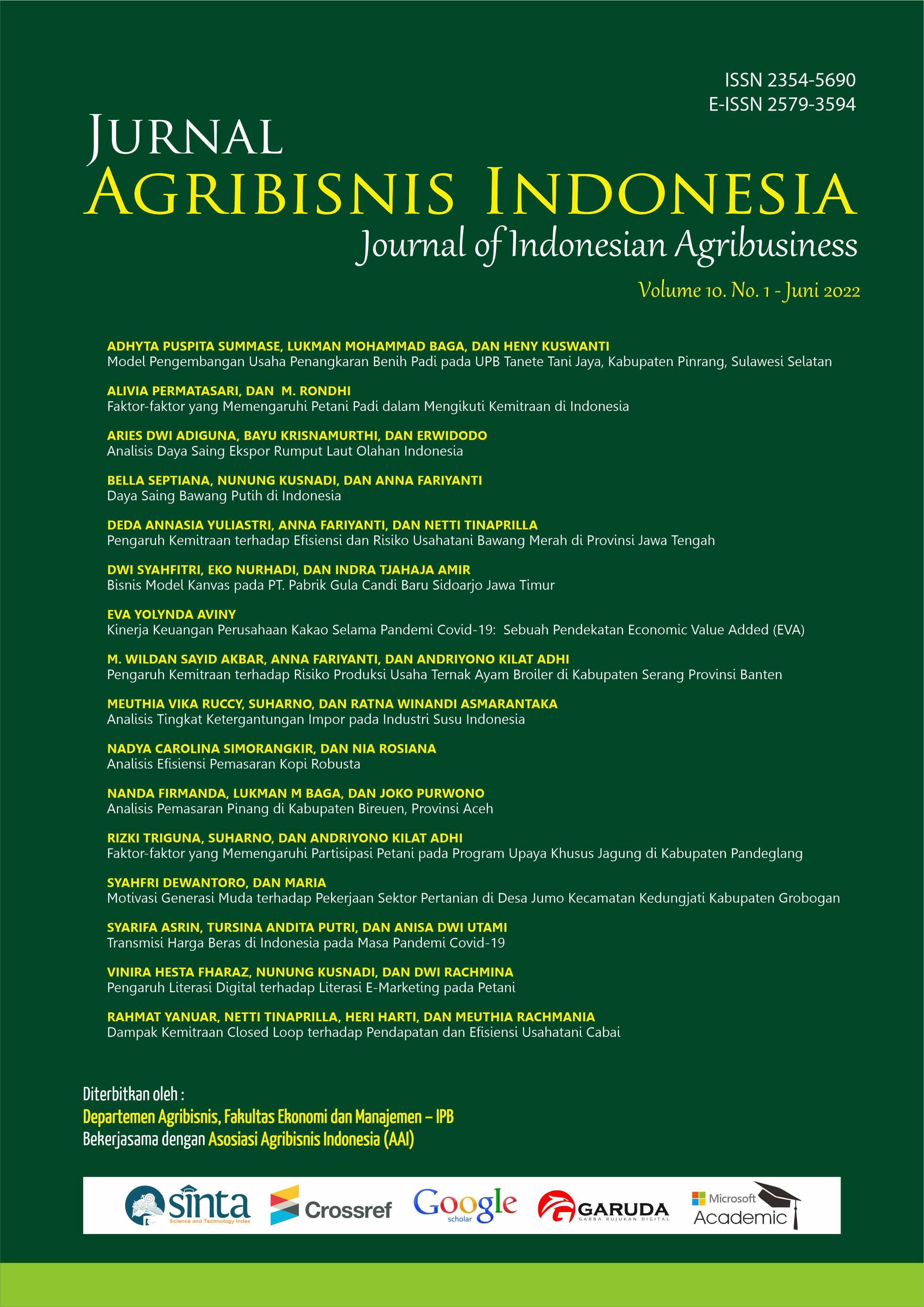Analisis Pemasaran Pinang di Kabupaten Bireuen, Provinsi Aceh
Main Article Content
Abstract
Indonesia is the fifth largest areca producer with a land area of 137,600 ha in 2015 with a production of 47.000 tons and a productivity of 0,34 tons/ha (Directorate General of Plantations, 2016). Aceh Province is one of the centers for areca cultivation in Indonesia. Areca is a commodity that is mostly cultivated by farmers in Bireuen Regency. So that, this commodity has an important role in the life of farmers in Bireuen Regency because their income depends on the areca cultivated. Generally, the weak bargaining position of farmers is due to the lack of market access and market information. Different price levels received by farmers will create marketing margins. This study aimed to identify and analyze areca marketing and analyze the operational efficiency of areca marketing in Bireuen Regency, Aceh Province. Qualitative descriptive analysis was used to analyze areca marketing channels. Meanwhile, quantitative analysis is used to measure the efficiency of areca marketing by using marketing margin analysis, farmer's share. The results showed that there were 3 marketing channels in Bireuen Regency which involved three marketing agencies, namely village collectors, sub-district collectors and wholesalers. There are 38 farmers (66,67 percent) that chose the first channel (Farmer – Village Collector Traders – Wholesalers). When viewed from the lowest margin (Rp 5.975,00/Kg) and the highest farmer's share (65,37 percent), the relatively efficient marketing channel is channel 2, namely Farmers-Wholesales. In the areca marketing, it appears that there is no institutional role at the farmer level in increasing the bargaining power of areca farmers in Bireuen Regency. Therefore, it is necessary to strengthen the role of farmer level institutions in the processing and marketing of areca in order to improve the bargaining position of areca farmers.
Downloads
Article Details

This work is licensed under a Creative Commons Attribution 4.0 International License.
Jurnal Agribisnis Indonesia (JAI) is an Open Access Journal. The authors who publish the manuscript in this journal agree to the following terms:
Creative Commons License
JAI is licensed under a Creative Commons Attribution 4.0 International License. This permits anyone to copy, redistribute, remix, transmit, and adapt the work provided the original work and source are appropriately cited.
This means:
(1) Under the CC-BY license, authors retain ownership of the copyright for their article, but authors grant others permission to use the content of publications in Jurnal Agribisnis Indonesia in whole or in part provided that the original work is properly cited. Users (redistributors) of JAI are required to cite the original source, including the author's name, JAI as the initial source of publication, year of publication, volume number, issue, and Digital Object Identifier (DOI); (2) Authors grant JAI the right of first publication. Although authors remain the copyright owner.
References
Anantanyu., dan Sapja. (2011). Kelembagaan Petani: Peran dan Strategi Pengembangan Kapasitasnya. Sepa. 7(2), 109-190.
Asmarantaka RW. 2012. Pemasaran Agribisnis (Agrimarketing). Bogor: Institut Pertanian Bogor.
[BPTP] Balai Pengkajian Teknologi Pertanian. 2009. Teknologi Budidaya Padi Sawah dengan Pendekatan PTT. Jakarta: Kementerian Pertanian.
Dilana, IA. 2013. Pemasaran dan nilai tambah biji kakao di Kabupaten Madiun Jawa Timur [tesis]. Bogor: Sekolah Pascasarjana, Institut Pertanian Bogor.
[DITJEBUN] Direktorat Jenderal Perkebunan. 2016. Statistik Perkebunan. Jakarta: Direktorat Jenderal Perkebunan.
Ertherington, M. 1984. Strategi Rehabilitasi Perkebunan Teh di Indonesia, hal. 109.
Ferry, Y. 2003. Strategi pengembangan pinang di Nangro Aceh Darussalam. Warta Penelitian dan pengembangan Tanaman industry.
Jumiati E, Darwanto, Hartono, Masyhuri. 2013. Analisis Saluran Pemasaran Dan Marjin Pemasaran Kelapa Dalam Di Daerah Perbatasan Kalimantan Timur. Jurnal AGRIFOR Volume XII Nomor 1.
Kohls, RL., dan J.N. Uhl. 2002. Marketing of Agricultural Products. Ninth Edition. Macmillan Company, New York.
Limbong, WH., dan Sitorus, P. 1987. Pengantar Pemasaran Pertanian jurusan Ilmu-Ilmu Sosial Pertanian. Bogor: Institut Pertanian Bogor.
Lutony, TL. 1993. Pinang Sirih: Komoditi Ekspor dan Serbaguna. Jakarta: Kanisius.
Mawardati (2015). Analisis Faktor-Faktor Yang Mempengaruhi Pendapatan Usahatani Pinang Kecamatan Sawang Kabupaten Aceh Utara. Agrisep, 16(1): 61-65.
Nasution, A., Handayani, S., Chairudin., Yuliani, H., dan Mahjali, S. (2019). Pengembangan Pinang Sebagai Tanaman Alternatif dan Pendukung Pendapatan Petani Kelapa Sawit di Kabupaten Aceh Barat. Jurnal Bisnis Tani, 5(1), 1-13.
Rahman, D., Elwamendri., dan Damayanti, Y. (2014). Analisis Tataniaga Pinang (Areca Catechu.L) pada Pasar Produsen di Kecamatan Muara Sabak Timur Kabupaten Tanjung Jabung Timur. Sosio Ekonomika Bisnis. 17(2):1-10.
Seran, M., Adar, D., dan Telnoni, H. (2019). Analisis Pemasaran Pinang di Kecamatan Amarasi Selatan, Kabupaten Kupang. Buletin Ilmiah IMPAS, 20(3), 222-230. https://doi.org/10.35508/impas.v20i03.1878
Sihombing, T. 2000. Budidaya dan Prospek Bisnis Pinang. Jakarta: Penebar Swadaya Jakarta.
Siregar, EL. 2010. Analisis Pendapatan Usahatani dan Pemasaran Nenas Bogor (Kasus Desa Sukaluyu, Kecamatan Taman Sari, Kabupaten Bogor). [Skripsi]. Bogor: Fakultas Ekonomi dan Manajemen, Institut Pertanian Bogor.

